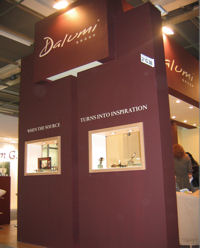A Show Too Far?
March 31, 08
| |
There’s Vicenza, Hong Kong, Basel, Vegas, Mumbai, New York, Bangkok- oh and now Goa and Macau. The list of diamond and jewelry trade shows goes on and on…and on. For companies trying to decide how to plan their budget, the trade show game is getting increasingly complicated. The question is does this multitude of shows benefit anyone other than the show organizers themselves? IDEX Magazine Editor-in-Chief Danielle Max spoke to a number of companies to gauge their opinions about the business of trade shows.
When it comes to the subject of trade shows, one question receives an overwhelming “Yes! Yes! Yes!” answer when it’s asked – the question of whether there are too many trade shows in this industry. The general consensus is that there are far too many trade events, with far too few effective results at far too great an expense.
According to Yael Palti, marketing manager of Israel-based Avi Paz Group Diamonds, which specializes in straight edged fancies, “There are way too many shows. The buyers can’t come to al l of them so the number of visitors at each show is decreasing. And for the exhibitors it is very expensive to participate in so many shows.”
Yuval Kemp, director of Marketing and Business Development of Dalumi, agrees, “I’ve worked in other industries and this one has the most shows, and they keep opening new ones. Why should there be three Macau shows or three Hong Kong shows?”
This thought is echoed by Itzik Yakubov, president of Yakubov Group, which specializes in manufacturing high quality goods 0.30-5 carats. Yakubov says, “I believe that there are too many trade shows in the industry, and for the most part, only the big, experienced or well-known trade show organizations generate a successful show. When considering a new trade show in our marketing plan we try to either attend as visitors for the first time or exhibit with minimum expenses as a test case. Of course, it is always important to keep in touch with the industry’s pulse, and i f a new show creates a big buzz, we would definitely examine it accordingly.”
While it is crystal clear that everyone thinks there are too many shows, it is worth asking if such cohesive agreement exists when it comes to a cost benefit analysis of how worthwhile the shows actually turn out to be. Furthermore, do companies participate in the shows for the business opportunities, or is it primarily because it is good PR to be there?
Raymond Cohen, managing director of Tache Company N.V., says his firm exhibits both for PR and for sales purposes. “We use the shows to meet new customers and to promote our name worldwide, as well as to service our existing customers by having a wide selection of goods available at the shows.”
|
|
'For Indian Sightholder Dimexon, trade shows offer something a bit more complex – an ideal platform for “new product and technology introductions and networking opportunities to strengthen relationships with existing clients and attract new clients.” The shows, says Paras Mehta, vice president of Sales, “allow us to establish and communicate our brand presence and help shorten the new business acquisition cycle. Trade shows also allow us to monitor competitive activity, understand product and design trends and access under one roof packaging, machinery and allied businesses.” He admits, however, that both new customer development and PR with existing clients are among the main reasons for attending the shows.
Yakubov says, “Our main reason for exhibiting in any trade show is first and foremost generating actual sales, whether it’s at the show location or after the show.” However, he says that a great part of any show is PR. “A significant part of our marketing strategy includes promotion: pre-show, at-show and post-show. From the PR standpoint, trade shows enable us to promote our company brand and products and are a great way to personally keep in touch with our target market’s audience whether it’s our long time clients or new potential clients. The main target in any trade show is to expand our business in the particular areas. Exhibiting at trade shows is an essential part of our marketing strategy.”
| |
Kemp emphasizes that Dalumi takes a radically different approach and says, “Shows are for sales. If we want to do PR then we’ll do PR. We measure the success of the shows on the amount of business generated. We don’t perceive them as a place to do PR.”
Just how useful are trade shows when it comes to business? Are they the glue that holds the industry together, or are they more or less expendable? Would the entire business world fall apart if they did not exist?
According to Raymond Cohen, there is no doubt that Tache would function to the same extent without trade shows, but he says, “Trade shows give an opening to different markets and allow us to introduce our company to potential clients. But the same results are achieved by a lot of other marketing and sales techniques.” He does, however, admit that, “Trade shows give an extra tool to serve customers and to establish our name in different markets. But they are not the dominant tool in doing so.”
'Mehta believes “trade shows are certainly an important medium for our industry; however, it is also a capital intensive proposition. We are judicious in our selection of trade shows to exhibit in and those to only visit.”
Says Yakubov, “Without trade shows, we would have reached the same results in a longer period of time and with more personal work on the field.”
In response to the question about the effectiveness of trade shows in terms of business generated, Cohen estimates that between two and five percent of Tache’s business is conducted at trade shows. However, he says “They give face-to-face contact with clients and give an opportunity to understand the demand of the markets better.”
Mehta also believes in their effectiveness, though he tempers his enthusiasm for the format. “A trade fair could be the starting point to attract customers but there are other ways to acquire customers like e-commerce and direct marketing,” he says. “A trade fair is a good platform to project your company’s brand and your product and services in a focused environment to the right target audience.”
Yakubov cautions, “It is hard to measure in numbers how much of our business is generated by trade shows as without product, service, customer relations and consistent fol low-up, none of the leads and potential long term clients we met at the show would continue to buy from us. Nevertheless, there is no doubt in my mind that attending a trade show can give a great sales and marketing boost to a company in a new market or existing market.”
With so many shows, it’s important to find out why companies attend the particular shows that they do.
Cohen explains that Tache attends Hong Kong (March, June, September and December), Macau (January), Lyon, Baselworld, Shanghai, JCK Las Vegas, JCK New Delhi, IIJS Mumbai and Shenzhen, while the group’s Alliance members participate in other shows – mostly in the U.S. The reason for attending these particular shows is clear. “For us, India and China are very important markets, as the whole Asia-Pacific region is covered by shows in Hong Kong, China, and India. A lot of our clients use the opportunities of the shows to come and see us closer to their home base. And it is easier for some of our clients to buy in tax-free zones such as Hong Kong.”
Dimexon also has an extensive list of shows in which it participates or attends: IJT, Hong Kong (Sept, March), Basel, IIJS, Shenzhen, JCK Las Vegas, Dubai, Turkey and Bahrain. “We exhibit in most of 'the shows mentioned except Turkey. These are by far some of the important trade shows in the year that cover the major diamond and jewelry markets. These are mature and well-managed shows that are attended by all the major companies within the diamond value chain,” says Mehta.
 |
When it comes down to it, what would make the whole trade show game more worthwhile?
Mehta thinks it boils down to ensuring the presence of “all the relevant entities within the diamond pipeline.” He also believes that structured buyer-seller meets would help. In addition, he feels that consolidating the number of shows would help business. In addition, he says, “The shows need to be planned better around buying cycles and should encourage actual transactions as in the case of Hong Kong. These offer an ideal platform for industry leaders to unite and discuss on common issues like synthetics, CSR, BPP etc.”
Palti suggests that it would be helpful if a greater number of visitors and clients attended the shows. “The organizers should focus more on bringing more buyers,” she asserts.
Kemp thinks that it is imperative that shows maintain their B2B status. “Some shows are now opening to the public. That’s a big ‘no no.’ The last thing you want at a show is some guy coming up to you because he wants to buy his girlfriend a ring.”
As for what organizers can do to make shows more effective, Kemp has his own ideas. “Anything that really [encourages] meetings between buyers and suppliers is positive,” he says. “Events such as the VNU CEO summit are much more effective. We need less trade shows and more forums; they are more intimate.”

